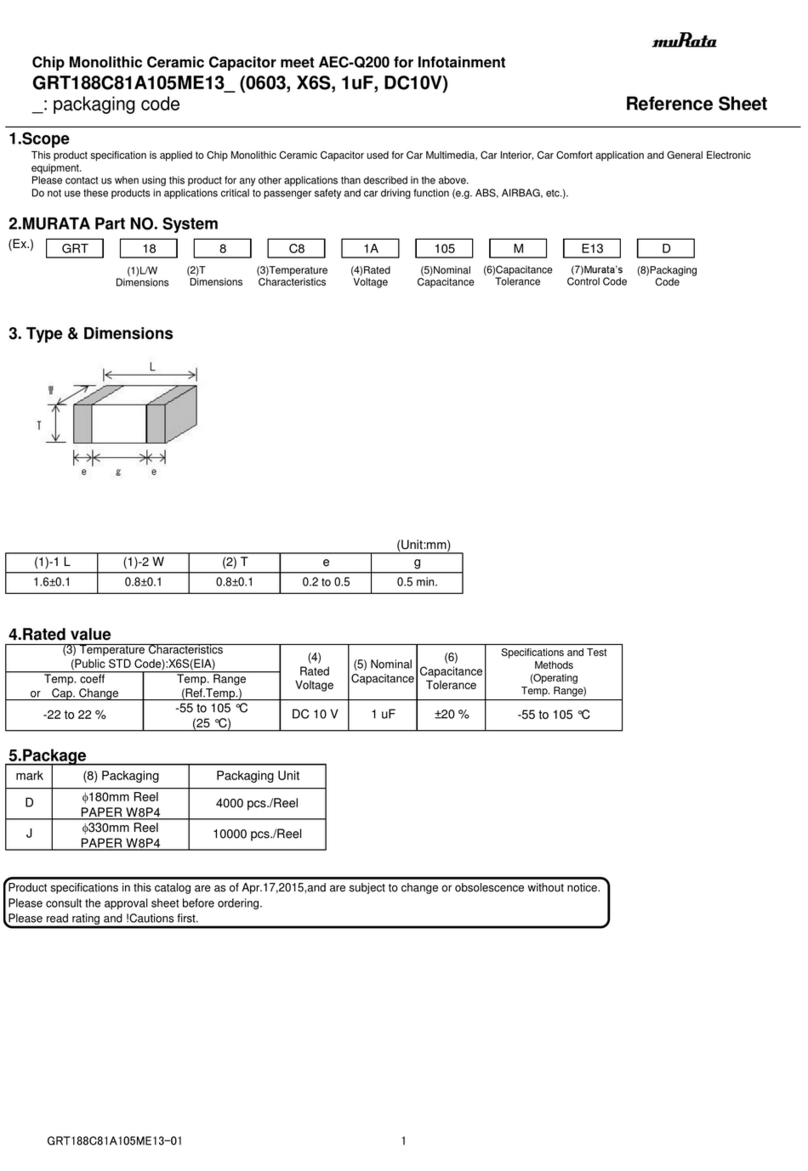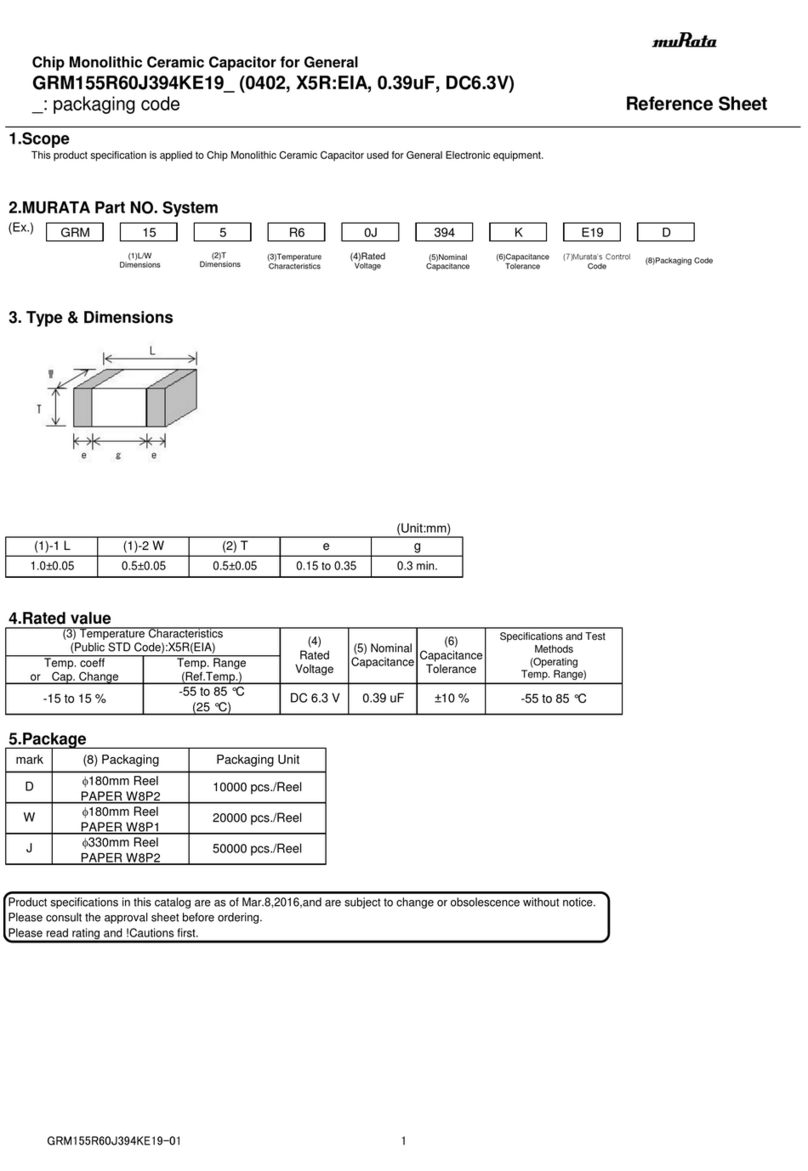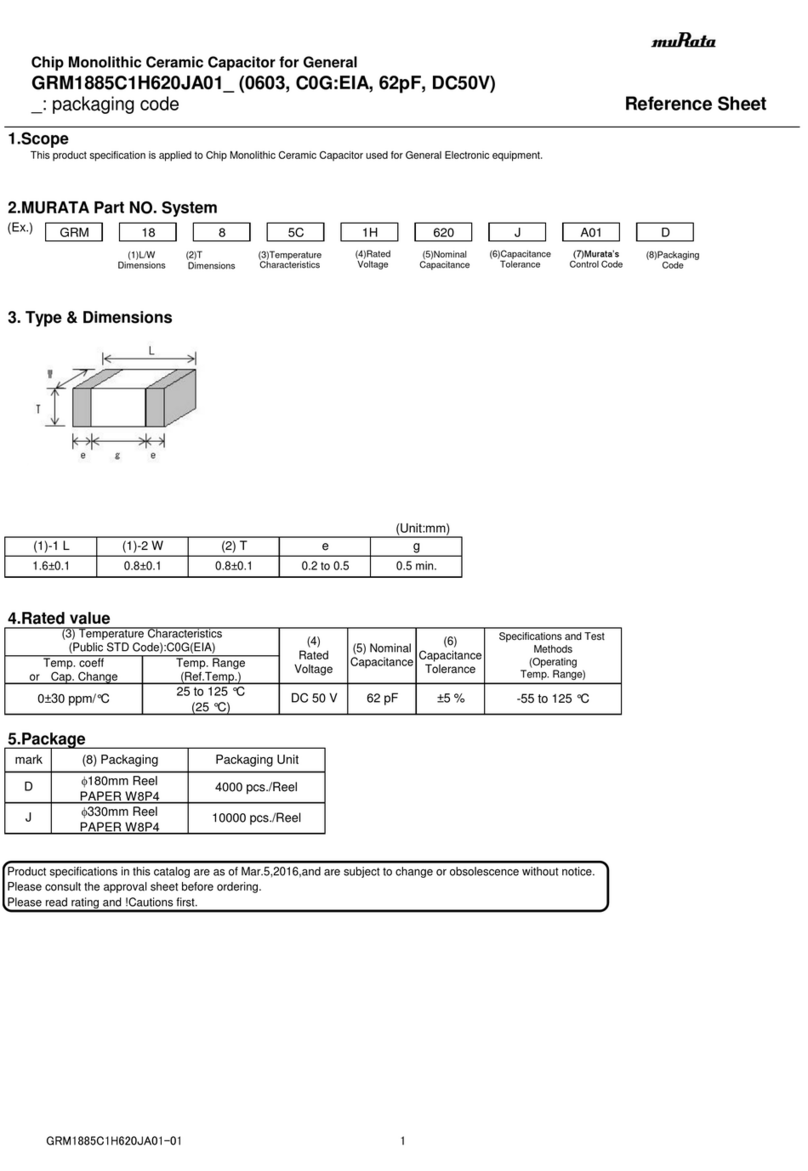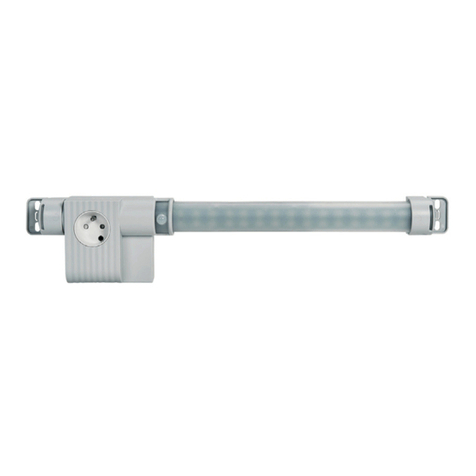Lincoln Electric Modular Fume Hood User manual

O erator’s Manual
Modular Fume Hood ™
Register your machine:
www.lincolnelectric.com/register
Authorized Service and Distributor Locator:
www.lincolnelectric.com/locator
IM10014-A | Issue D ate Dec-17
© Lincoln Glo al, Inc. All Rights Reserved.
For use with machines having Code Num ers:
AD1234-80 thru AD1234-134
Save for future reference
Date Purchased
Code: (ex: 10859)
Serial: (ex: U1060512345)

THANK YOU FOR SELECTING
A QUALITY PRODUCT BY
LINCOLN ELECTRIC.
PLEASE EXAMINE CARTON AND EQUIPMENT FOR
DAMAGE IMMEDIATELY
When this equipment is shipped, title passes to the purchaser
upon receipt by the carrier. Consequently, claims for material
damaged in shipment must be made by the purchaser against the
transportation company at the time the shipment is received.
SAFETY DEPENDS ON YOU
Lincoln arc welding and cutting equipment is designed and built
with safety in mind. However, your overall safety can be increased
by proper installation ... and thoughtful operation on your part.
DO NOT INSTALL, OPERATE OR REPAIR THIS EQUIPMENT
WITHOUT READING THIS MANUAL AND THE SAFETY
PRECAUTIONS CONTAINED THROUGHOUT. And, most importantly,
think before you act and be careful.
This statement appears where the information must be followed
exactly to avoid serious personal injury or loss of life.
This statement appears where the information must be followed
to avoid minor personal injury or damage to this equipment.
KEEP YOUR HEAD OUT OF THE FUMES.
DON’T get too close to the arc.
Use corrective lenses if necessary
to stay a reasonable distance
away from the arc.
READ and obey the Safety Data
Sheet (SDS) and the warning label
that appears on all containers of
welding materials.
USE ENOUGH VENTILATION or
exhaust at the arc, or both, to
keep the fumes and gases from
your breathing zone and the general area.
IN A LARGE ROOM OR OUTDOORS, natural ventilation may be
adequate if you keep your head out of the fumes (See below).
USE NATURAL DRAFTS or fans to keep the fumes away
from your face.
If you develop unusual symptoms, see your supervisor.
Perhaps the welding atmosphere and ventilation system
should be checked.
WEAR CORRECT EYE, EAR &
BODY PROTECTION
PROTECT your eyes and face with welding helmet
properly fitted and with proper grade of filter plate
(See ANSI Z49.1).
PROTECT your body from welding spatter and arc
flash with protective clothing including woolen
clothing, flame-proof apron and gloves, leather
leggings, and high boots.
PROTECT others from splatter, flash, and glare
with protective screens or barriers.
IN SOME AREAS, protection from noise may be appropriate.
BE SURE protective equipment is in good condition.
Also, wear safety glasses in work area
AT ALL TIMES.
SPECIAL SITUATIONS
DO NOT WELD OR CUT containers or materials which previously
had been in contact with hazardous substances unless they are
properly cleaned. This is extremely dangerous.
DO NOT WELD OR CUT painted or plated parts unless special
precautions with ventilation have been taken. They can release
highly toxic fumes or gases.
Additional precautionary measures
PROTECT compressed gas cylinders from excessive heat,
mechanical shocks, and arcs; fasten cylinders so they cannot fall.
BE SURE cylinders are never grounded or part of an
electrical circuit.
REMOVE all potential fire hazards from welding area.
ALWAYS HAVE FIRE FIGHTING EQUIPMENT READY FOR
IMMEDIATE USE AND KNOW HOW TO USE IT.
WARNING
CAUTION
Safety 01 of 04 - 5/16/2018

SECTION A:
WARNINGS
CALIFORNIA PROPOSITION 65 WARNINGS
WARNING: Breathing diesel engine exhaust
exposes you to chemicals known to the State
of California to cause cancer and birth defects,
or other reproductive harm.
• Always start and operate the engine in a
well-ventilated area.
• If in an exposed area, vent the exhaust to the outside.
• Do not modify or tamper with the exhaust system.
• Do not idle the engine except as necessary.
For more information go to
www.P65 warnings.ca.gov/diesel
WARNING: This product, when used for welding or
cutting, produces fumes or gases which contain
chemicals known to the State of California to cause
birth defects and, in some cases, cancer. (California
Health & Safety Code § 25249.5 et seq.)
WARNING: Cancer and Reproductive Harm
www.P65warnings.ca.gov
ARC WELDING CAN BE HAZARDOUS. PROTECT
YOURSELF AND OTHERS FROM POSSIBLE SERIOUS
INJURY OR DEATH. KEEP CHILDREN AWAY.
PACEMAKER WEARERS SHOULD CONSULT WITH
THEIR DOCTOR BEFORE OPERATING.
Read and understand the following safety highlights. For
additional safety information, it is strongly recommended
that you purchase a copy of “Safety in Welding & Cutting -
ANSI Standard Z49.1” from the American Welding Society,
P.O. Box 351040, Miami, Florida 33135 or CSA Standard
W117.2-1974. A Free copy of “Arc Welding Safety” booklet
E205 is available from the Lincoln Electric Company,
22801 St. Clair Avenue, Cleveland, Ohio 44117-1199.
BE SURE THAT ALL INSTALLATION, OPERATION,
MAINTENANCE AND REPAIR PROCEDURES ARE
PERFORMED ONLY BY QUALIFIED INDIVIDUALS.
FOR ENGINE POWERED
EQUIPMENT.
1.a. Turn the engine off before troubleshooting
and maintenance work unless the
maintenance work requires it to be running.
1.b. Operate engines in open, well-ventilated areas or vent the engine
exhaust fumes outdoors.
1.c. Do not add the fuel near an open flame welding
arc or when the engine is running. Stop the
engine and allow it to cool before refueling to
prevent spilled fuel from vaporizing on contact
with hot engine parts and igniting. Do not spill fuel when filling
tank. If fuel is spilled, wipe it up and do not start engine until
fumes have been eliminated.
1.d. Keep all equipment safety guards, covers
and devices in position and in good repair.
Keep hands, hair, clothing and tools away
from V-belts, gears, fans and all other
moving parts when starting, operating or
repairing equipment.
1.e. In some cases it may be necessary to remove safety guards to
perform required maintenance. Remove guards only when
necessary and replace them when the maintenance requiring
their removal is complete. Always use the greatest care when
working near moving parts.
1.f. Do not put your hands near the engine fan. Do not attempt to
override the governor or idler by pushing on the throttle control
rods while the engine is running.
1.g. To prevent accidentally starting gasoline engines while turning
the engine or welding generator during maintenance work,
disconnect the spark plug wires, distributor cap or magneto wire
as appropriate.
1.h. To avoid scalding, do not remove the radiator
pressure cap when the engine is hot.
ELECTRIC AND
MAGNETIC FIELDS MAY
BE DANGEROUS
2.a. Electric current flowing through any conductor
causes localized Electric and Magnetic Fields (EMF).
Welding current creates EMF fields around welding cables
and welding machines
2.b. EMF fields may interfere with some pacemakers, and
welders having a pacemaker should consult their physician
before welding.
2.c. Exposure to EMF fields in welding may have other health effects
which are now not known.
2.d. All welders should use the following procedures in order to
minimize exposure to EMF fields from the welding circuit:
2.d.1. Route the electrode and work cables together - Secure
them with tape when possible.
2.d.2. Never coil the electrode lead around your body.
2.d.3. Do not place your body between the electrode and work
cables. If the electrode cable is on your right side, the
work cable should also be on your right side.
2.d.4. Connect the work cable to the workpiece as close as pos-
sible to the area being welded.
2.d.5. Do not work next to welding power source.
SAFETY
Safety 02 of 04 - 5/16/2018

ELECTRIC SHOCK
CAN KILL.
3.a. The electrode and work (or ground) circuits are
electrically “hot” when the welder is on. Do
not touch these “hot” parts with your bare skin or wet clothing.
Wear dry, hole-free gloves to insulate hands.
3.b. Insulate yourself from work and ground using dry insulation.
Make certain the insulation is large enough to cover your full area
of physical contact with work and ground.
In addition to the normal safety precautions, if
welding must be performed under electrically
hazardous conditions (in damp locations or while
wearing wet clothing; on metal structures such as
floors, gratings or scaffolds; when in cramped
positions such as sitting, kneeling or lying, if there
is a high risk of unavoidable or accidental contact
with the workpiece or ground) use the following
equipment:
• Semiautomatic DC Constant Voltage (Wire) Welder.
• DC Manual (Stick) Welder.
• AC Welder with Reduced Voltage Control.
3.c. In semiautomatic or automatic wire welding, the electrode,
electrode reel, welding head, nozzle or semiautomatic welding
gun are also electrically “hot”.
3.d. Always be sure the work cable makes a good electrical
connection with the metal being welded. The connection should
be as close as possible to the area being welded.
3.e. Ground the work or metal to be welded to a good electrical (earth)
ground.
3.f. Maintain the electrode holder, work clamp, welding cable and
welding machine in good, safe operating condition. Replace
damaged insulation.
3.g. Never dip the electrode in water for cooling.
3.h. Never simultaneously touch electrically “hot” parts of electrode
holders connected to two welders because voltage
between the
two can be the total of the open circuit voltage of both
welders.
3.i. When working above floor level, use a safety belt to protect
yourself from a fall should you get a shock.
3.j. Also see Items 6.c. and 8.
ARC RAYS CAN BURN.
4.a. Use a shield with the proper filter and cover plates to protect your
eyes from sparks and the rays of the arc when welding or
observing open arc welding. Headshield and filter lens should
conform to ANSI Z87. I standards.
4.b. Use suitable clothing made from durable flame-resistant material
to protect your skin and that of your helpers from the arc rays.
4.c. Protect other nearby personnel with suitable, non-flammable
screening and/or warn them not to watch the arc nor expose
themselves to the arc rays or to hot spatter or metal.
FUMES AND GASES
CAN BE DANGEROUS.
5.a. Welding may produce fumes and gases
hazardous to health. Avoid breathing these
fumes and gases. When welding, keep your head out of the fume.
Use enough ventilation and/or exhaust at the arc to keep fumes
and gases away from the breathing zone. When welding
hardfacing (see instructions on container or SDS)
or on lead or cadmium plated steel and other
metals or coatings which produce highly toxic
fumes, keep exposure as low as possible and
within applicable OSHA PEL and ACGIH TLV limits
using local exhaust or mechanical ventilation
unless exposure assessments indicate otherwise.
In confined spaces or in some circumstances,
outdoors, a respirator may also be required.
Additional precautions are also required when
welding
on galvanized steel.
5. b. The operation of welding fume control equipment is affected by
various factors including proper use and positioning of the
equipment, maintenance of the equipment and the specific
welding procedure and application involved. Worker exposure
level should be checked upon installation and periodically
thereafter to be certain it is within applicable OSHA PEL and
ACGIH TLV limits.
5.c. Do not weld in locations near chlorinated hydrocarbon vapors
coming from degreasing, cleaning or spraying operations. The
heat and rays of the arc can react with solvent vapors to form
phosgene, a highly toxic gas, and other irritating products.
5.d. Shielding gases used for arc welding can displace air and
cause
injury or death. Always use enough ventilation, especially in
confined areas, to insure breathing air is safe.
5.e. Read and understand the manufacturer’s instructions for this
equipment and the consumables to be used, including the
Safety Data Sheet (SDS) and follow your employer’s safety
practices. SDS forms are available from your welding
distributor or from the manufacturer.
5.f. Also see item 1.b.
SAFETY
Safety 03 of 04 - 5/16/2018

WELDING AND CUTTING
SPARKS CAN CAUSE
FIRE OR EXPLOSION.
6.a. Remove fire hazards from the welding area. If
this is not possible, cover them to prevent the welding sparks
from starting a fire. Remember that welding sparks and hot
materials from welding can easily go through small cracks and
openings to adjacent areas. Avoid welding near hydraulic lines.
Have a fire extinguisher readily available.
6.b. Where compressed gases are to be used at the job site, special
precautions should be used to prevent hazardous situations.
Refer to “Safety in Welding and Cutting” (ANSI Standard Z49.1)
and the operating information for the equipment being used.
6.c. When not welding, make certain no part of the electrode circuit is
touching the work or ground. Accidental contact can cause
overheating and create a fire hazard.
6.d. Do not heat, cut or weld tanks, drums or containers until the
proper steps have been taken to insure that such procedures
will not cause flammable or toxic vapors from substances inside.
They can cause an explosion even though they have been
“cleaned”. For information, purchase “Recommended Safe
Practices for the Preparation for Welding and Cutting of
Containers and Piping That Have Held Hazardous Substances”,
AWS F4.1 from the American Welding Society
(see address above).
6.e. Vent hollow castings or containers before heating, cutting or
welding. They may explode.
6.f. Sparks and spatter are thrown from the welding arc. Wear oil free
protective garments such as leather gloves, heavy shirt, cuffless
trousers, high shoes and a cap over your hair. Wear ear plugs
when welding out of position or in confined places. Always wear
safety glasses with side shields when in a welding area.
6.g. Connect the work cable to the work as close to the welding area
as practical. Work cables connected to the building framework or
other locations away from the welding area increase the
possibility of the welding current passing through lifting chains,
crane cables or other alternate circuits. This can create fire
hazards or overheat lifting chains or cables until they fail.
6.h. Also see item 1.c.
6.I. Read and follow NFPA 51B “Standard for Fire Prevention During
Welding, Cutting and Other Hot Work”, available from NFPA, 1
Batterymarch Park, PO box 9101, Quincy, MA 022690-9101.
6.j. Do not use a welding power source for pipe thawing.
CYLINDER MAY EXPLODE IF
DAMAGED.
7.a. Use only compressed gas cylinders containing
the correct shielding gas for the process used
and properly operating regulators designed for
the gas and pressure used. All hoses, fittings,
etc. should be suitable for the application and
maintained in good condition.
7.b. Always keep cylinders in an upright position securely chained to
an undercarriage or fixed support.
7.c. Cylinders should be located:
• Away from areas where they may be struck or subjected
to physical damage.
• A safe distance from arc welding or cutting operations
and any other source of heat, sparks, or flame.
7.d. Never allow the electrode, electrode holder or any other
electrically “hot” parts to touch a cylinder.
7.e. Keep your head and face away from the cylinder valve outlet
when opening the cylinder valve.
7.f. Valve protection caps should always be in place and hand tight
except when the cylinder is in use or connected for use.
7.g. Read and follow the instructions on compressed gas cylinders,
associated equipment, and CGA publication P-l, “Precautions for
Safe Handling of Compressed Gases in Cylinders,” available from
the Compressed Gas Association, 14501 George Carter Way
Chantilly, VA 20151.
FOR ELECTRICALLY
POWERED EQUIPMENT.
8.a. Turn off input power using the disconnect
switch at the fuse box before working on
the equipment.
8.b. Install equipment in accordance with the U.S. National Electrical
Code, all local codes and the manufacturer’s recommendations.
8.c. Ground the equipment in accordance with the U.S. National
Electrical Code and the manufacturer’s recommendations.
Refer to
http://www.lincolnelectric.com/safety
for additional safety information.
SAFETY
Safety 04 of 04 - 5/16/2018

2
SAFETY
As a rule of thumb, for many mild steel electrode, if the air is visibly
clear and you are comfortable, then the ventilation is generally
adequate for your work. The most accurate way to determine if the
worker exposure does not exceed the applicable exposure limit for
compounds in the fumes and gases is to have an industrial hygienist
take and analyze a sample of the air you are breathing. This is
particularly important if you are welding with stainless, hardfacing or
Special Ventilation products. All Lincoln MSDS have a maximum fume
guideline number. f exposure to total fume is kept below that
number, exposure to all fume from the electrode (not coatings or
plating on the work) will be below the TLV.
There are steps that you can take to identify hazardous substances in
your welding environment. Read the product label and material safety
data sheet for the electrode posted in the work place or in the
electrode or flux container to see what fumes can be reasonably
expected from use of the product and to determine if special
ventilation is needed. Secondly, know what the base metal is and
determine if there is any paint, plating, or coating that could expose
you to toxic fumes and/or gases. Remove it from the metal being
welded, if possible. f you start to feel uncomfortable, dizzy or
nauseous, there is a possibility that you are being overexposed to
fumes and gases, or suffering from oxygen deficiency. Stop welding
and get some fresh air immediately. Notify your supervisor and co-
workers so the situation can be corrected and other workers can
avoid the hazard. Be sure you are following these safe practices, the
consumable labeling and MSDS to improve the ventilation in your
area. Do not continue welding until the situation has been corrected.
NOTE: The MSDS for all incoln consumables is available on incoln’s web-
site: www.lincolnelectric.com
Before we turn to the methods available to control welding fume
exposure, you should understand a few basic terms:
Natura Venti ation is the movement of air through the
workplace caused by natural forces. Outside, this is usually
the wind. nside, this may be the flow of air through open
windows and doors.
Mechanica Venti ation is the movement of air through the
workplace caused by an electrical device such as a portable
fan or permanently mounted fan in the ceiling or wall.
Source Extraction (Local Exhaust) is a mechanical device
used to capture welding fume at or near the arc and filter
contaminants out of the air.
The ventilation or exhaust needed for your application depends upon
many factors such as:
• Workspace volume
• Workspace configuration
• Number of welders
• Welding process and current
• Consumables used (mild steel, hardfacing, stainless, etc.)
• Allowable levels (TLV, PEL, etc.)
• Material welded (including paint or plating)
• Natural airflow
Your work area has adequate ventilation when there is enough
ventilation and/or exhaust to control worker exposure to hazardous
materials in the welding fumes and gases so the applicable limits for
those materials is not exceeded. See chart of TLV and PEL for Typical
Electrode ngredients, the OSHA PEL (Permissible Exposure Limit), and
the recommended guideline, the ACG H TLV (Threshold Limit Value),
for many compounds found in welding fume.
Ventil tion
There are many methods which can be selected by the user to
provide adequate ventilation for the specific application. The following
section provides general information which may be helpful in
evaluating what type of ventilation equipment may be suitable for
your application. When ventilation equipment is installed, you should
confirm worker exposure is controlled within applicable OSHA PEL
and/or ACG H TLV. According to OSHA regulations, when welding and
cutting (mild steels), natural ventilation is usually considered
sufficient to meet requirements, provided that:
1. The room or welding area contains at least 10,000 cubic feet
(about 22' x 22' x 22') for each welder.
2. The ceiling height is not less than 16 feet.
3. Cross ventilation is not blocked by partitions, equipment, or
other structural barriers.
4. Welding is not done in a confined space.
Spaces that do not meet these requirements should be equipped with
mechanical ventilating equipment that exhausts at least 2000 CFM of
air for each welder, except where local exhaust hoods or booths, or
air-line respirators are used.
Import nt S fety Note:
When welding with electrodes which require speci l
ventil tion such s st inless or h rdf cing (see
instructions on cont iner or MSDS) or on le d or
c dmium pl ted steel nd other met ls or co tings which
produce h z rdous fumes, keep exposure s low s
possible nd below exposure limit v lues (PEL nd TLV)
for m teri ls in the fume using loc l exh ust or
mech nic l ventil tion. In con ned sp ces or in some
circumst nces, for ex mple outdoors, respir tor m y
be required if exposure c nnot be controlled to the PEL
or TLV. (See MSDS nd ch rt of TLV nd PEL for Typic l
Electrode Ingredients.) Addition l prec utions re lso
required when welding on g lv nized steel.

3
SAFETY
BIBLIOGRA HY AND SUGGESTED READING
ANS Z87.1, Practice for Occupational and Educational Eye and Face
Protection, American National Standards nstitute, 11 West 42nd
Street, New York, NY 10036.
Arc Welding and Your Health: A Handbook of Health nformation for
Welding. Published by The American ndustrial Hygiene Association,
2700 Prosperity Avenue, Suite 250, Fairfax, VA 22031-4319.
NFPA Standard 51B, Cutting and Welding Processes, National Fire
Protection Association, 1 Batterymarch Park, P.O. Box 9146, Quincy,
MA 02269-9959.
OSHA General ndustry Standard 29 CFR 1910 Subpart Q. OSHA
Hazard Communication Standard 29 CFR 1910.1200. Available from
the Occupational Safety and Health Administration at
http://www.osha.org or contact your local OSHA office.
The following publications are published by The American Welding
Society, P.O. Box 351040, Miami, Florida 33135. AWS publications
may be purchased from the American Welding society at
http://www.aws.org or by contacting the AWS at 800-443-9353.
ANS , Standard Z49.1, Safety in Welding, Cutting and Allied
Processes. Z49.1 is now available for download at no charge at
http://www.lincolnelectric.com/community/safety/ or at the AWS
website http://www.aws.org.
AWS F1.1, Method for Sampling Airborne Particulates Generated by
Welding and Allied Processes.
AWS F1.2, Laboratory Method for Measuring Fume Generation Rates
and Total Fume Emission of Welding and Allied Processes.
AWS F1.3, Evaluating Contaminants in the Welding Environment: A
Strategic Sampling Guide.
AWS F1.5, Methods for Sampling and Analyzing Gases from Welding
and Allied Processes.
AWS F3.2, Ventilation Guide for Welding Fume Control
AWS F4.1, Recommended Safe Practices for the Preparation for
Welding and Cutting of Containers and Piping That Have Held
Hazardous Substances.
AWS SHF, Safety and Health Facts Sheets. Available free of charge
from the AWS website at http://www.aws.org.
Supplemental Information:
(*) Not listed. Nuisance value maximum is 10 milligrams per cubic
meter. PE value for iron oxide is 10 milligrams per cubic meter.
T V value for iron oxide is 5 milligrams per cubic meter.
(**) As respirable dust.
(*****) Subject to the reporting requirements of Sections 311, 312,
and 313 of the Emergency Planning and Community Right-
to-Know Act of 1986 and of 40CFR 370 and 372.
(b) The PE for chromium (VI) is .005 milligrams per cubic meter as
an 8 hour time weighted average. The T V for water-soluble
chromium (VI) is 0.05 milligrams per cubic meter. The T V for
insoluble chromium (VI) is 0.01 milligrams per cubic meter.
(c) Values are for manganese fume. STE (Short Term Exposure
imit) is 3.0 milligrams per cubic meter. OSHA PE is a ceiling
value.
(****) The T V for soluble barium compounds is 0.5 mg/m3.
T V and PE values are as of October 2013. Always check Safety
Data Sheet (SDS) with product or on the incoln Electric website at
http://www.lincolnelectric.com
LISTED BELOW ARE SOME TY ICAL INGREDIENTS IN WELDING ELECTRODES AND
THEIR TLV (ACGIH) GUIDELINES AND EL (OSHA) EX OSURE LIMITS
INGREDIENTS CAS No. TLV mg/m3EL mg/m3
Aluminum and/or aluminum alloys (as AI)***** 7429-90-5 1.0 15
Aluminum oxide and/or Bauxite***** 1344-28-1 1. 0 5**
Barium compounds (as Ba)***** 513-77-9 0.5 0.5
Chromium and chromium alloys or compounds (as Cr)***** 7440-47-3 0.5(b) 0.5(b)
Hexavalent Chromium (Cr VI) 18540-29-9 0.05(b) .005(b)
Copper Fume 7440-50-8 0.2 0.1
Cobalt Compounds 7440-48-4 0.02 0.1
Fluorides (as F) 7789-75-5 2.5 2.5
Iron 7439-89-6 10* 10*
imestone and/or calcium carbonate 1317-65-3 10* 15
ithium compounds (as i) 554-13-2 15 10*
Magnesite 1309-48-4 10 15
Magnesium and/or magnesium alloys and compounds (as Mg) 7439-95-4 10* 10*
Manganese and/or manganese alloys and compounds (as Mn)***** 7439-96-5 0.02 5.0(c)
Mineral silicates 1332-58-7 5** 5**
Molybdenum alloys (as Mo) 7439-98-7 10 10
Nickel***** 7440-02-0 0.1 1
Silicates and other binders 1344-09-8 10* 10*
Silicon and/or silicon alloys and compounds (as Si) 7440-21-3 10* 10*
Strontium compounds (as Sr) 1633-05-2 10* 10*
Zirconium alloys and compounds (as Zr) 12004-83-0 5 5

4
TABLE OF CONTENTS
MODULAR FUME HOOD™
..........................................................................................................................................................PAGE
Installation.......................................................................................................................Section A
Technical Specifications.......................................................................................................A-1
General Description..............................................................................................................A-2
Components.........................................................................................................................A-2
Tools.....................................................................................................................................A-2
npacking............................................................................................................................A-2
Mounting Possibilities...........................................................................................................A-3
Assembly References - Single Compartment......................................................................A-4
Assembly References - Double Compartment.....................................................................A-5
Assembly References - Triple Compartment.......................................................................A-6
Single Compartment.............................................................................................................A-7
Leg Mounting........................................................................................................................A-8
Hood Compartment Width 5 or 6.5ft (1.5 or 2m).................................................................. A-9
Modular Fume Hood XL Double Compartment.................................................................. A-10
Modular Fume Hood XL Triple Compartment....................................................................A-11
Operation.........................................................................................................................Section B
Operation..............................................................................................................................B-1
Intended se........................................................................................................................B-1
Accessories..................................................................................................... Section C
Options / Accessories............................................................................................C-1
Maintenance....................................................................................................Section D
Service, Maintenance and Repairs.......................................................................D-1
Maintenance..........................................................................................................D-1
Periodic Maintenance............................................................................................D-1
Maintenance Schedule..........................................................................................D-2
PARTS LIST ...............................................................................................................PARTS.LINCOLNELECTRIC.COM
Content/details may be changed or updated without notice. For most current nstruction Manuals, go to
parts.lincolnelectric.com.

A-1
INSTALLATIONMODULAR FUME HOOD™
TECHNICAL
SPECIFICATIONS
MODULAR FUME HOOD
HOOD SIZE
M N MUM HOOD S ZE 3.5 X 5 FT (1 X 1.5 M)
MAX MUM HOOD S ZE 18 X 18 FT (5.5 X 5.5 M)
Check the available Product Data Sheets for extensive product specifications.
RECOMMENDED EXTRACTION CAPACITY
27 - 44 CFM per ft
2
(500 - 800 m
3
/h per m
2
) of hood
PRESSURE LOSS OVER HOOD
Max. 1 in. WG (250 Pa)

A-2
INSTALLATIONMODULAR FUME HOOD™
GENERAL DESCRIPTION
The Modular Fume Hood is a reliable and practical solution to
contain and extract welding, cutting, arc gouging and grinding
fume from the work environment. t is designed to connect to an
external extraction/filtration system. The hood can be hung from
the ceiling or mounted on legs.
This manual describes the following types of hoods:
This chapter describes the installation of single, double and triple
compartment modular fume hoods.
• Single compartment modular fume hoods consist of one row
of roof panels.
• Double compartment modular fume hoods consist of two
rows of roof panels with two cross-mounted main frame
profiles in between.
• Triple compartment modular fume hoods consist of three
rows of roof panels with four cross-mounted main frame
profiles in between.
The cross-profiles are connected to the main frame profiles by
T-brackets.
COMPONENTS
The Modular Fume hood consists of the following main
components (See Figure A.1):
A. Connection flange set(s)
B. Top roof panels
C. Main frame profiles
D. Bottom roof panels
E. Corner piece sets
F. Corner covers
G. H-profiles
Additionally for Modular Fume Hood XL:
H. T-brackets
. Main frame profiles used as cross-profiles
f parts are missing or damaged, contact your supplier.
Remove protection foil from roof panels.
FIGURE –
A.1
TOOLS
UNPACkING
Check that the product is complete. The Modular Fume hood is
built up of the following components/sets:
- 4 main frame profiles
- 2 corner sets
- 1 corner cover set
- 1 roof panel set (basic)
- Roof panel set(s) (extension) - for hood/compartment lengths
> 3.5 ft (1.5 m)
- 1 or 2 connection flanges
- 1 branding set
Welding strips + strip bracket set(s) - Lincoln Electric supplies as
standard
Additionally for Modular Fume Hoods XL:
- 2 or 4 main frame profiles to be used as cross profiles
- T-brackets
- 3 to 6 connection flange(s)
Optionally available:
- Legs + floor mounting set
- Corner reinforcement (for leg-mounted modular fume hoods
XL)
- Lighting fixture
Min. Size Max. Size
Modular Fume Hood:
- Single Compartment
3.5 X 5 FT
(1.0 X 1.5 M)
6.5 X 18 FT
(2.0 X 5.5 M)
Modular Fume hood XL:
- Double compartment
- Triple compartment
8 X 8 FT
(2.5 X 2.5 M)
8 X 15 FT
(2.5 X 4.5 M)
13 X 18 FT
(4.0 X 5.5M)
18 X 18 FT
(5.5 X 5.5 M)
C
D
E
G
H
I
F
B
A
Electric drill
- socket 7 mm
- socket 10 mm
Pair of pliers to
fasten vertical
spacers
Jigsaw to make cut-
outs in roof panels
Glueing clamp for
mounting of legs
Razor knife for
cutting welding
strips
Fork-lift truck(s)
with long forks for
mounting of hood
XL: cargo lashing
(option)
XL: stack of pallets
(option)

A-3
INSTALLATIONMODULAR FUME HOOD™
NOTE: The best way to assemble a Modular Fume Hood XL is to
place a stack of pallets under each corner of the hood and
one or two additional stacks under the loose ends of the
cross-profiles.
NOTE: It is strongly recommended to lift a Modular Fume Hood XL
using two fork-lift trucks. Make sure to lift the hood by the
profiles, not by the roof panels.
n case a standing hood XL is to be positioned in a corner:
• Position the hood roughly using two fork-lift trucks.
• Put some pallets on the forks of one fork-lift truck.
f necessary, use additional beams.
• Lift the hood in the middle and place it on the final position.
MOUNTING POSSIbILITIES
- Standard: hanging by chains (chain links min. 0.3 in./8 mm; to
be sourced locally)
- Option: standing on legs + floor mounting set
- A combination of both (e.g. 2 chains + 2 legs)
For a hanging mounted configuration, check that the roof is
strong enough. eights of Modular Fume Hoods are listed in the
S31225-77 tables published on the following pages.
Refer Assembly Reference Section of the manual for detailed
information.
Use proper m teri l to mount the ch ins. If
necess ry: consult the rchitect of the building.
CAUTION

A-4
INSTALLATIONMODULAR FUME HOOD™
EN-168
S31225-77 A.03
SINGLE COMPARTMENTS
TOP LEVEL NUMBER ARTICLE NUMBER NO. OF FLANGES DESCRIPTION A B C D E F G H ~ WEIGHT (Kg) ~ WEIGHT (lbs)
AD1234-80 S28058-30 1FUME HOOD, MODULAR 1m x 1.5m KIT 42.40 62.10 38.60 58.30 31.05 21.20 21.20 31.05 70 155
AD1234-81 S28058-31 1FUME HOOD, MODULAR 1m x 2m KIT 42.40 81.78 38.60 77.98 31.05 21.20 21.20 50.73 80 177
AD1234-82 S28058-32 1FUME HOOD, MODULAR 1m x 2.5m KIT 42.40 101.46 38.60 97.66 50.73 21.20 21.20 50.73 92 204
AD1234-83 S28058-33 2FUME HOOD, MODULAR 1m x 3m KIT 42.40 121.14 38.60 117.34 31.05 21.20 21.20 31.05 104 230
AD1234-84 S28058-34 2FUME HOOD, MODULAR 1m x 3.5m KIT 42.40 140.82 38.60 137.02 31.05 21.20 21.20 31.05 115 254
AD1234-85 S28058-35 2FUME HOOD, MODULAR 1m x 4m KIT 42.40 160.50 38.60 156.70 50.73 21.20 21.20 50.73 126 278
AD1234-98 S28058-80 2FUME HOOD, MODULAR 1m x 4.5m KIT 42.40 180.18 38.60 176.38 50.73 21.20 21.20 50.73 137 303
AD1234-99 S28058-81 2FUME HOOD, MODULAR 1M x 5M KIT 42.40 199.86 38.60 196.06 50.73 21.20 21.20 50.73 148 326
AD1234-100 S28058-82 2FUME HOOD, MODULAR 1m x 5.5m KIT 42.40 219.54 38.60 215.74 70.41 21.20 21.20 70.41 159 350
AD1234-86 S28058-36 1FUME HOOD, MODULAR 1.5m x 1.5m KIT 62.10 62.10 58.30 58.30 31.05 31.05 31.05 31.05 82 182
AD1234-87 S28058-37 1FUME HOOD, MODULAR 1.5m x 2.5m KIT 62.10 101.46 58.30 97.66 50.73 31.05 31.05 50.73 111 244
AD1234-88 S28058-38 2FUME HOOD, MODULAR 1.5m x 3m KIT 62.10 121.14 58.30 117.34 31.05 31.05 31.05 31.05 125 276
AD1234-89 S28058-39 2FUME HOOD, MODULAR 1.5m x 3.5m KIT 62.10 140.82 58.30 137.02 31.05 31.05 31.05 31.05 139 306
AD1234-90 S28058-40 2FUME HOOD, MODULAR 1.5m x 4m KIT 62.10 160.50 58.30 156.70 50.73 31.05 31.05 50.73 153 337
AD1234-101 S28058-83 2FUME HOOD, MODULAR 1.5m x 4.5m KIT 62.10 180.18 58.30 176.38 50.73 31.05 31.05 50.73 167 369
AD1234-102 S28058-84 2FUME HOOD, MODULAR 1.5m x 5m KIT 62.10 199.86 58.30 196.06 50.73 31.05 31.05 50.73 180 398
AD1234-103 S28058-85 2FUME HOOD, MODULAR 1.5m x 5.5m KIT 62.10 219.54 58.30 215.74 70.41 31.05 31.05 70.41 194 429
AD1234-91 S28058-41 1FUME HOOD, MODULAR 2m x 1.5m KIT 81.78 62.10 77.98 58.30 31.05 40.89 40.89 31.05 94 208
AD1234-92 S28058-42 1FUME HOOD, MODULAR 2m x 2m KIT 81.78 81.78 77.98 77.98 31.05 40.89 40.89 50.73 109 241
AD1234-93 S28058-43 1FUME HOOD, MODULAR 2m x 2.5m KIT 81.78 101.46 77.98 97.66 50.73 40.89 40.89 50.73 127 281
AD1234-94 S28058-44 2FUME HOOD, MODULAR 2m x 3m KIT 81.78 121.14 77.98 117.34 31.05 40.89 40.89 31.05 145 320
AD1234-95 S28058-45 2FUME HOOD, MODULAR 2m x 3.5m KIT 81.78 140.82 77.98 137.02 31.05 40.89 40.89 31.05 161 356
AD1234-96 S28058-46 2FUME HOOD, MODULAR 2m x 4m KIT 81.78 160.50 77.98 156.70 50.73 40.89 40.89 50.73 178 392
AD1234-104 S28058-86 2FUME HOOD, MODULAR 2m x 4.5m KIT 81.78 180.18 77.98 176.38 50.73 40.89 40.89 50.73 195 430
AD1234-105 S28058-87 2FUME HOOD, MODULAR 2m x 5m KIT 81.78 199.86 77.98 196.06 50.73 40.89 40.89 50.73 211 466
AD1234-106 S28058-88 2FUME HOOD, MODULAR 2m x 5.5m KIT 81.78 219.54 77.98 215.74 70.41 40.89 40.89 70.41 227 502
A C
B
D
E H
F
G
A C
B
D
E H
G
F
SINGLE FLANGE
TWO FLANGES
ALL DIMENSIONS ARE IN INCHES
REFER DIAGRAMS BASED ON THE NO. OF FLANGES AND ASSEMBLY PART NUMBER IN THE TABLE
NOTES:
NA. A DIMENSIONS MENTIONED IN THIS DATA SHEET ARE APPROXIMATE
AND INDICATIVE, ACTUA PHYSICA ASSEMB Y DIMENSIONS MAY VARY
AND SUBJECT TO CHANGE BASED ON MANUFACTURING DRAWINGS.
NB. WEIGHTS IN THE TAB E ARE APPROXIMATE AND INDICATIVE.
NC. C AND D ARE HANGING DIMENSIONS.

A-5
INSTALLATIONMODULAR FUME HOOD™
S31225-77 A.03
DOUBLE COMPARTMENTS
TOP LEVEL NUMBER ARTICLE NUMBER NO. OF FLANGES DESCRIPTION A B C D E F G H ~ WEIGHT (Kg) ~ WEIGHT (lbs)
AD1234-107 S28058-89 2FUME HOOD, MODULAR 2.5m x 2.5m KIT 104.49 101.46 100.69 97.66 50.73 31.05 21.20 50.73 162 357
AD1234-108 S28058-90 2FUME HOOD, MODULAR 3m x 2.5m KIT 124.17 101.46 120.37 97.66 50.73 31.05 31.05 50.73 183 405
AD1234-109 S28058-91 4FUME HOOD, MODULAR 3m x 3m KIT 124.17 121.14 120.37 117.34 31.05 31.05 31.05 31.05 209 462
AD1234-110 S28058-92 4FUME HOOD, MODULAR 3m x 4.5m KIT 124.17 180.18 120.37 176.38 50.73 31.05 31.05 50.73 295 651
AD1234-111 S28058-93 2FUME HOOD, MODULAR 3.5m x 2.5m KIT 143.86 101.46 140.06 97.66 50.73 40.89 31.05 50.73 201 444
AD1234-112 S28058-94 4FUME HOOD, MODULAR 3.5m x 3m KIT 143.86 121.14 140.06 117.34 31.05 40.89 31.05 31.05 230 508
AD1234-113 S28058-95 4FUME HOOD, MODULAR 3.5m x 3.5m KIT 143.86 140.82 140.06 137.02 31.05 40.89 31.05 31.05 264 582
AD1234-114 S28058-96 4FUME HOOD, MODULAR 3.5m x 4.5m KIT 143.86 180.18 140.06 176.38 50.73 40.89 31.05 50.73 324 715
AD1234-115 S28058-97 4FUME HOOD, MODULAR 3.5m x 5m KIT 143.86 199.86 140.06 196.06 50.73 40.89 31.05 50.73 354 781
AD1234-116 S28058-98 2FUME HOOD, MODULAR 4m x 2.5m KIT 163.54 101.46 159.74 97.66 50.73 40.89 40.89 50.73 219 483
AD1234-117 S28058-99 4FUME HOOD, MODULAR 4m x 3m KIT 163.54 121.14 159.74 117.34 31.05 40.89 40.89 31.05 251 554
AD1234-118 S28058-100 4FUME HOOD, MODULAR 4m x 3.5m KIT 163.54 140.82 159.74 137.02 31.05 40.89 40.89 31.05 287 634
AD1234-119 S28058-101 4FUME HOOD, MODULAR 4m x 4m KIT 163.54 160.50 159.74 156.70 50.73 40.89 40.89 50.73 320 706
AD1234-120 S28058-102 4FUME HOOD, MODULAR 4m x 4.5m KIT 163.54 180.18 159.74 176.38 50.73 40.89 40.89 50.73 352 778
AD1234-121 S28058-103 4FUME HOOD, MODULAR 4m x 5m KIT 163.54 199.86 159.74 196.06 50.73 40.89 40.89 50.73 385 850
AD1234-122 S28058-104 4FUME HOOD, MODULAR 4m x 5.5m KIT 163.54 219.54 159.74 215.74 70.41 40.89 40.89 70.41 418 922
A C
B
D
E H
F
G
E H
F
G
B
D
A C
FOUR FLANGES
TWO FLANGES
X1
X2
X1
X2
POSITION OF
COMPARTMENT
A
(Inch)
X1
(Meter)
X2
(Meter)
104.49 1.5 1
124.17 1.5 1.5
143.86 2 1.5
163.54 2 2
ALL DIMENSIONS ARE IN INCHES
REFER DIAGRAMS BASED ON THE NO. OF FLANGES AND ASSEMBLY PART NUMBER IN THE TABLE
NOTES:
NA. A DIMENSIONS MENTIONED IN THIS DATA SHEET ARE
APPROXIMATE AND INDICATIVE, ACTUA PHYSICA
ASSEMB Y DIMENSIONS MAY VARY AND SUBJECT TO
CHANGE BASED ON MANUFACTURING DRAWINGS.
NB. WEIGHTS IN THE TAB E ARE APPROXIMATE AND INDICA-
TIVE.
NC. COMPARTMENT ARRANGEMENT (X1 & X2) CAN BE VARIED
DEPENDING ON THE REQUIREMENT OF CUSTOMER.
ND. C AND D ARE HANGING DIMENSIONS.

A-6
INSTALLATIONMODULAR FUME HOOD™
S31225-77 A.03
TRIPLE COMPARTMENTS
TOP LEVEL NUMBER ARTICLE NUMBER NO. OF FLANGES DESCRIPTION A B C D E F G H J ~ WEIGHT (Kg) ~ WEIGHT (lbs)
AD1234-123 S28058-105 3FUME HOOD, MODULAR 4.5m x 2.5m KIT 186.26 101.46 182.46 97.66 50.73 31.05 31.05 50.73 93.13 268 591
AD1234-124 S28058-106 6FUME HOOD, MODULAR 4.5m x 4.5m KIT 186.26 180.18 182.46 176.38 50.73 31.05 31.05 50.73 93.13 437 965
AD1234-125 S28058-107 3FUME HOOD, MODULAR 5m x 2.5m KIT 205.94 101.46 202.14 97.66 50.73 40.89 31.05 50.73 112.83 285 630
AD1234-126 S28058-108 6FUME HOOD, MODULAR 5m x 3m KIT 205.94 121.14 202.14 117.34 31.05 40.89 31.05 31.05 112.83 333 734
AD1234-127 S28058-109 6FUME HOOD, MODULAR 5m x 4.5m KIT 205.94 180.18 202.14 176.38 50.73 40.89 31.05 50.73 112.83 466 1028
AD1234-128 S28058-110 6FUME HOOD, MODULAR 5m x 5m KIT 205.94 199.86 202.14 196.06 50.73 40.89 31.05 50.73 112.83 509 1123
AD1234-129 S28058-111 3FUME HOOD, MODULAR 5.5m x 2.5m KIT 225.63 101.46 221.83 97.66 50.73 40.89 31.05 50.73 122.67 303 669
AD1234-130 S28058-112 6FUME HOOD, MODULAR 5.5m x 3m KIT 225.63 121.14 221.83 117.34 31.05 40.89 31.05 31.05 122.67 353 780
AD1234-131 S28058-113 6FUME HOOD, MODULAR 5.5m x 3.5m KIT 225.63 140.82 221.83 137.02 31.05 40.89 31.05 31.05 122.67 400 882
AD1234-132 S28058-114 6FUME HOOD, MODULAR 5.5m x 4.5m KIT 225.63 180.18 221.83 176.38 50.73 40.89 31.05 50.73 122.67 495 1092
AD1234-133 S28058-115 6FUME HOOD, MODULAR 5.5m x 5m KIT 225.63 199.86 221.83 196.06 50.73 40.89 31.05 50.73 122.67 540 1193
AD1234-134 S28058-116 6FUME HOOD, MODULAR 5.5m x 5.5m KIT 225.63 219.54 221.83 215.74 70.41 40.89 31.05 70.41 122.67 587 1295
E H
A C
B
D
F
J
G
B
D
A C
F
J
G
E H
SIX FLANGES
THREE FLANGES
X1
X3
X2
X1
X2
X3
POSITION OF
COMPARTMENT
A
(Inch)
X1
(Meter)
X2
(Meter)
X3
(Meter)
186.26 1.5 1.5 1.5
205.94 2 1.5 1.5
225.63 2 2 1.5
ALL DIMENSIONS ARE IN INCHES
REFER DIAGRAMS BASED ON THE NO. OF FLANGES AND ASSEMBLY PART NUMBER IN THE TABLE
NOTES:
NA. A DIMENSIONS MENTIONED IN THIS DATA SHEET ARE
APPROXIMATE AND INDICATIVE, ACTUA PHYSICA
ASSEMB Y DIMENSIONS MAY VARY AND SUBJECT TO
CHANGE BASED ON MANUFACTURING DRAWINGS.
NB. WEIGHTS IN THE TAB E ARE APPROXIMATE AND INDICA-
TIVE.
NC. COMPARTMENT ARRANGEMENT (X1, X2 & X3) CAN BE
VARIED DEPENDING ON THE REQUIREMENT OF CUS-
TOMER.
ND. C AND D ARE HANGING DIMENSIONS.

A-7
INSTALLATIONMODULAR FUME HOOD™
Carefully read and follow the instructions before
proceeding to make any cut-outs on the panels.
To mount the Modular Fume Hood proceed as fol-
lows:
SINGLE COM ARTMENT
In c se of m king double or triple comp rtment hood,
c refully re d through the respective sections before
proceeding to the below steps
1. Form a U-shape using 3 main frame profiles and 2 outside
corner pieces. See Figure A.2.
FIGURE – A.2
2. Slide the main frame profiles halfway over the outside corner
pieces. See Figure A.3.
FIGURE – A.3
3. Place the inside corner pieces (1) and slide in the main frame
profiles (2). Fasten the corner piece (3) to the main frame
profiles with self-tapping screws. Use inside corner pieces as
template. See Figure A.4.
FIGURE – A.4
Refer to “A-TOP”, “B-BOTTOM” nd “C-BOTTOM
END” m rkings on the p nels for e sy identi-
fic tion nd ssembly.
Remove protection foil from roof p nels before ssembly.
P nel identific tion m rkings re on the foil nd m ke sure
not to remove the foils t one time from ll p nels, this m y
le d to difficulties with ssembly.
4. Make cutouts in the “A-TOP” roof panels that will be mounted
in the corners. See Figure A.5.
For double nd triple comp rtment hoods, do not
m ke cut-outs on both corners of the “A-TOP”
p nel. Review the “A-TOP” p nel l y-out nd cut
only on the required corners. Corner cutting is not required
for the “A-TOP” p nel ssembled dj cent to the T
-br ckets.
FIGURE – A.5
90°
90°
1
2
2
3
10 mm
A
B
B
A
mm inch
A45 1.8
B10 0.4
ATTENTION
ATTENTION
ATTENTION

A-8
INSTALLATIONMODULAR FUME HOOD™
In case of leg mounting:
5. Make cut-aways in two “C-BOTTOM END” roof panels
(W = 18.8 in. / 477mm) for mounting of legs. See Figure A.6.
For double nd triple comp rtment hoods, do
not m ke cut-outs on both corners of the “C-
BOTTOM END” p nel. Review the “C-BOTTOM
END” p nel l y-out nd cut only on the required corners.
Corner cutting is not required for the “C-BOTTOM END”
p nel ssembled dj cent to the T-br ckets.
FIGURE – A.6
6. Apply distance holders (1) to “C-BOTTOM END” roof panel
(W = 18.8 in.477 mm) according to Table A.7.
TABLE – A.7
7. Slide “C-BOTTOM END” roof panel in main frame profile (2).
See Figure A.8.
Note: In case of eg mounting, make sure to use / cut the
“C-BOTTOM END” pane as per figure A.6
8 . Apply distance holders to the sides of the “C-BOTTOM END”
roof panel(3). See Figure A.8.
FIGURE – A.8
9. Place a long H-profile.
10. Place “A-TOP” roof panel.
Note: Use the “A-TOP” pane which has corners cut as per
Figure A.5
11. Place a short H-profile.
Hood/compartment width 5 or 6.5 ft (1.5 or 2 m):
12. Place 2 vertical spacers between the H-profiles (1). See
Figure A.9 and Table A.7
13. Fasten them using a pair of pliers (2). See Figure A.9.
FIGURE – A.9
3.5 ft
5ft
6.5 ft
A
A
B
mm inch
A98 3.86
B r=98 r=3.86
1
3
2
1
2
1/2 1/41/4
ATTENTION

A-9
INSTALLATIONMODULAR FUME HOOD™
14. Determine position and number of connection flanges
according to S31225-77 Table. Refer the assembly
references section of the manual.
15. Make necessary cutout(s) in “A-TOP” roof panel(s), using the
inner flange ring as a template.
16. Mount connection flange(s). See Figure A.10.
FIGURE – A.10
17. Continue to place the “B-BOTTOM” roof panels with side
distance holders, “A-TOP” roof panels, H-profiles and vertical
spacers (if applicable) and “C-BOTTOM END” roof panel at
the end with distance holders except for the last “A-TOP”
roof panel. See Figure A.11.
Corner cut-out to be dded for the l st “A-TOP”
roof p nel s per figure A.5 nd in c se of leg
mounting, m ke sure to use the “C-BOTTOM
END” p nel with corner cut-out s per Figure A.6
FIGURE – A.11
18. Mount the remaining inner and outer corner pieces (1) and
main frame profile (2). See Figure A.12.
FIGURE – A.12
19. Place the last “A-TOP” roof panel and fasten them all. See
Figure A.13.
FIGURE – A.13
20. Slide the branding strips in the main frame profiles. See
Figure A.14.
FIGURE A.14
7 mm
1
2
10 mm
7 mm
ATTENTION

A-10
INSTALLATIONMODULAR FUME HOOD™
MODULAR FUME HOOD XL;
DOUBLE COM ARTMENT:
For double comp rtment hoods, do not
m ke cut-outs on both corners of the
“A-TOP” nd “C-BOTTOM END” p nels.
Review the “A-TOP” nd “C-BOTTOM
END” p nel l y-out nd cut only on the required corners.
Corner cutting is not required for the p nel ssembled
dj cent to the T-br ckets.
a) Follow steps 1 to 3 as per single compartment
In case of Modular Fume Hood XL/standing:
Mount connection plates (2 plates on each on all four corners) of
corner reinforcement set on the main profiles using self-tapping
screws. See Figure A.15.
FIGURE – A.15
b) Mount a T-bracket on the main frame profile. See Figure A.16
c) Determine the right distance between the profiles by means
of a long H-profile. See Figure A.17.
d) Mount two cross profiles on T-bracket. See Figure A.17.
e) Place the other T-bracket on the loose side of cross-profiles
to keep them together. Do not fasten the screws yet. See
Figure A.17.
f) Make sure the cross-profiles are precisely square (90°) to the
main frame profile. See Figure A.17.
g) Finish the entire compartment (except for the last “A-TOP”
roof panel) before continuing with the next compartment. See
Figure A.17 and Figure A.12. Follow steps 4 to 18 as per
single compartment
h) Use a cargo lashing (1) around the end of the profiles to keep
them in the right position.
i) Fasten the T-bracket to the cross profiles and the main frame
profile.
j) Follow steps 19 and 20 as per single compartment
A
XL
mm inch
A 450 17.7
10 mm
ATTENTION

A-11
INSTALLATIONMODULAR FUME HOOD™
MODULAR FUME HOOD XL;
TRI LE COM ARTMENT:
For triple comp rtment hoods, do not m ke
cut-outs on both corners of the “A-TOP” nd
“C-BOTTOM END” p nels. Review the “A-TOP”
nd “C-BOTTOM END” p nel l y-out nd cut
only on the required corners. Corner cutting is not required
for the p nel ssembled dj cent to the T-br ckets.
a) Follow steps 1 to 3 as per single compartment
In case of Modular Fume Hood XL/standing:
Mount connection plates (2 plates on each on all four corners) of
corner reinforcement set on the main profiles using self-tapping
screws. See Figure A.15.
b) Mount two T-brackets on the main frame profile. See Figure
A.16.
c) Determine the ideal position of the T-brackets by means of
the long H-profiles to be used between the roof panels.
d) Mount two cross profiles on each T-bracket. See Figure A.17.
e) Place the other T-bracket(s) on the loose side of cross-profiles
to keep them together. Do not fasten the screws yet. See
Figure A.17.
f) Make sure the cross-profiles are precisely square (90°) to the
main frame profile. See Figure A.17.
g) Finish the entire compartment (except for the last “A-TOP”
roof panel) before continuing with the next compartment. See
Figure A.17 and Figure A.12. Follow steps 4 to 18 as per
single compartment
h) Use a cargo lashing (1) around the end of the profiles to keep
them in the right position.
i) Fasten the T-bracket(s) to the cross profiles and the main
frame profile.
j) Follow steps 19 and 20 as per single compartment
FIGURE – A.16
FIGURE – A.17
Fig. VIII
90°
90°
XL
1
XL
10 mm
T-BRACKET
ATTENTION

A-12
INSTALLATIONMODULAR FUME HOOD™
Hanging:
1. Lift the hood, preferably using a fork-lift. See Figure A.18.
2. Mount the hood to the ceiling. See Figure A.18.
FIGURE – A.18
Standing:
1. Mount the floor mounting plates under the legs (1). See Figure
A.19.
2. Lift the hood, preferably using a fork-lift truck (2). Modular
Fume Hood XL: use two fork-lift trucks. See Figure A.19.
3. Position the legs under the corners of the hood (3). The round
sides of the legs should be directed to the inside. t is
recommended to call in four persons to hold the legs. See
Figure A.19.
4. Let down the hood easily, until it rests on all four legs. See
Figure A.19.
FIGURE – A.19
5. Make sure to position the legs as close to the corner pieces as
possible, preferably using clamps. See Figure A.20.
6. Fasten the legs to the corner pieces. See Figure A.20.
FIGURE – A.20
7. Place the corner covers. See Figure A.21.
FIGURE – A.21
Modular Fume Hood XL/standing:
1. Mount the corner reinforcements to the connection plates using
bolts and locknuts (1). See Figure A.22.
2. Mount the corner reinforcement to the legs using self-tapping
screws (2). See Figure A.22.
FIGURE – A.22
1
2
10 mm
Fig. XVIII
10 mm
1
2
1
2
10 mm
XL
Table of contents
Popular Industrial Electrical manuals by other brands

Murata
Murata GJM1555C1H3R7BB01 Series Reference sheet
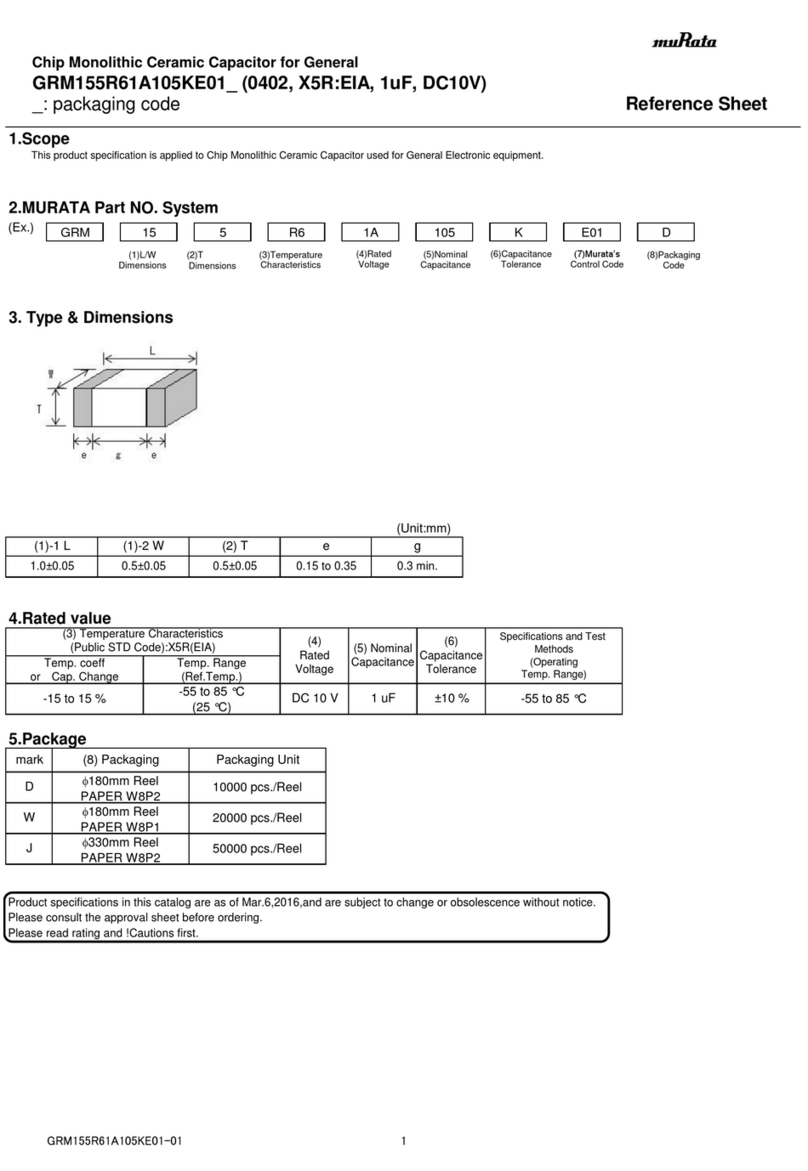
Murata
Murata GRM155R61A105KE01 Series Reference sheet
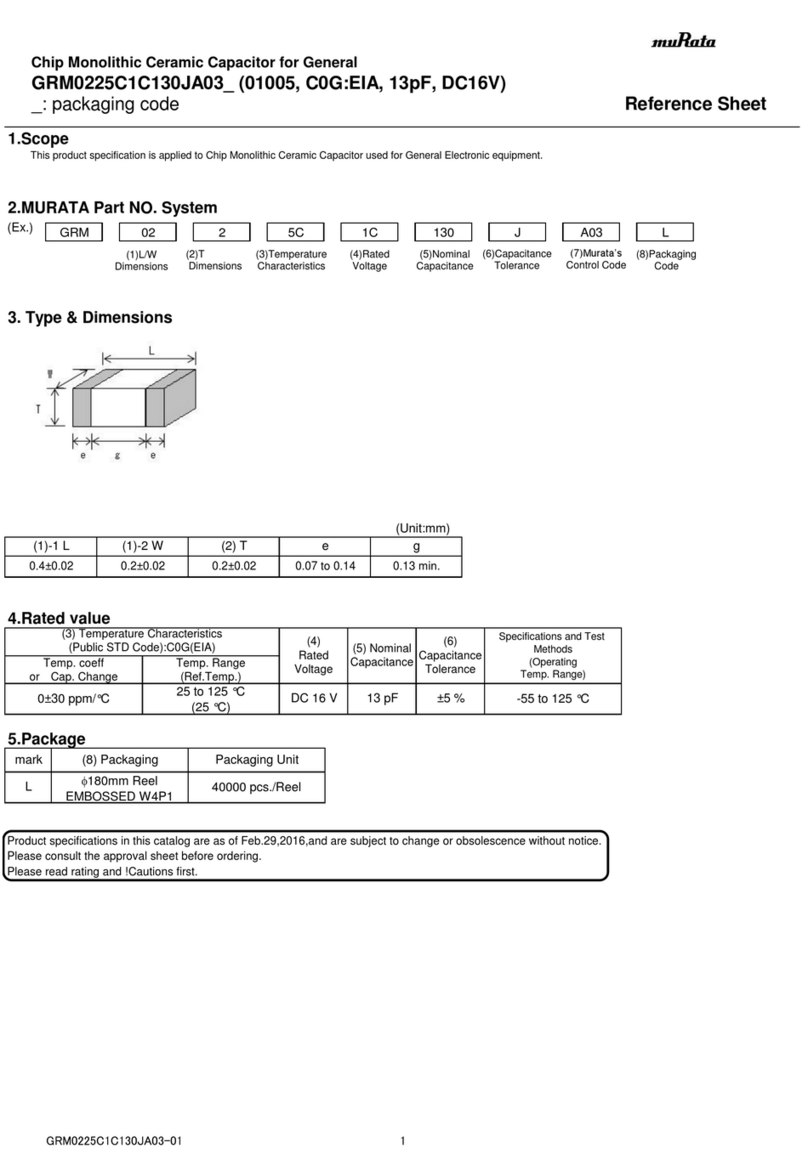
Murata
Murata GRM0225C1C130JA03 Series Reference sheet
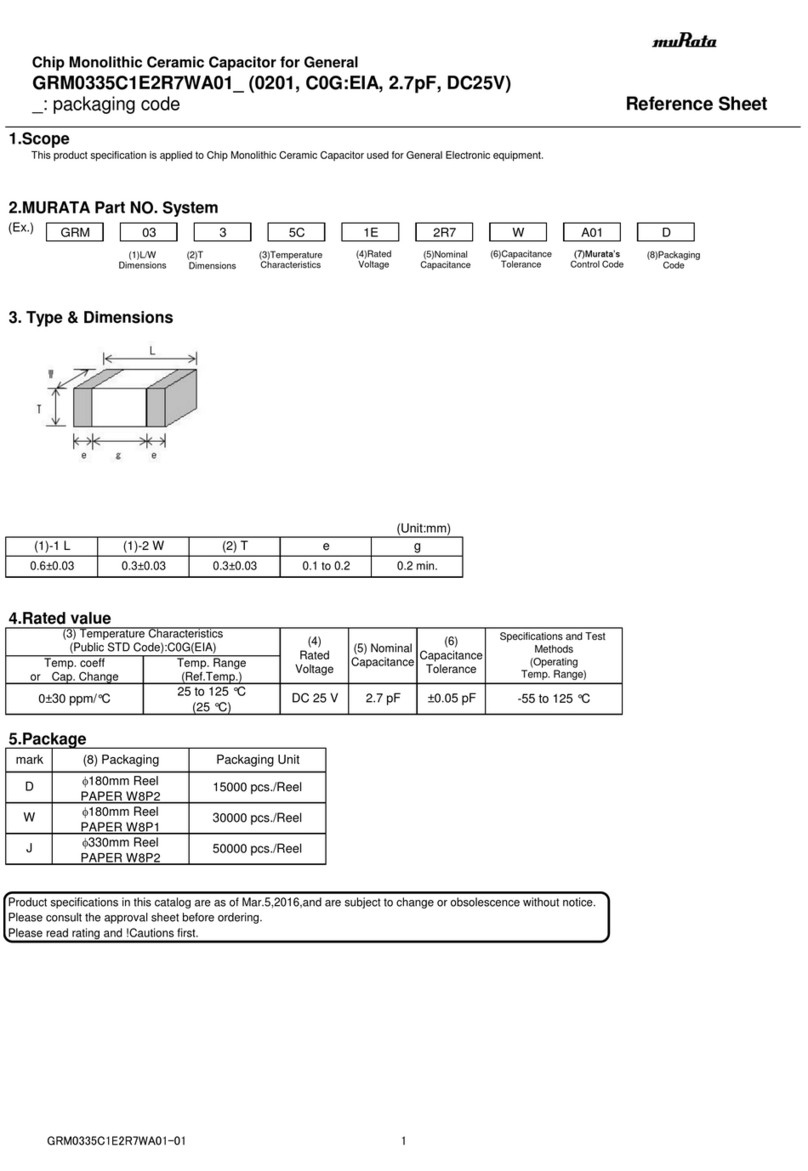
Murata
Murata GRM0335C1E2R7WA01 Series Reference sheet
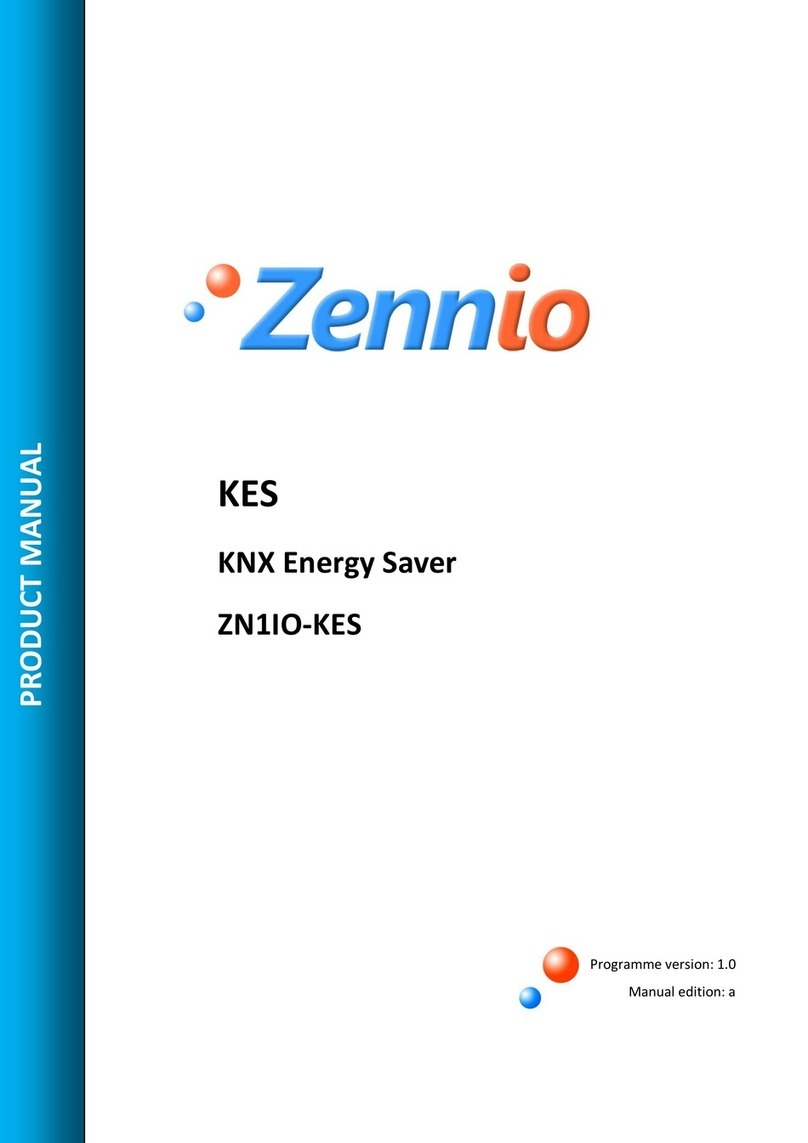
Zennio
Zennio KES Series product manual
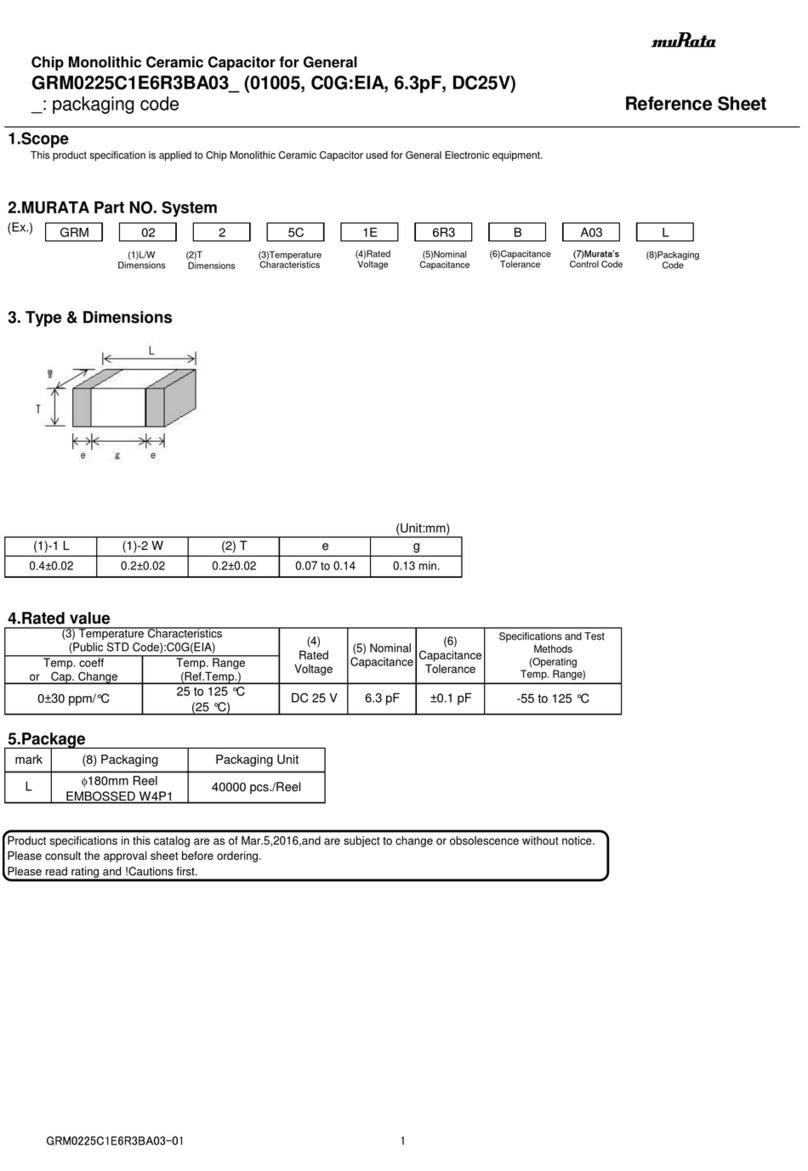
Murata
Murata GRM0225C1E6R3BA03 Series Reference sheet
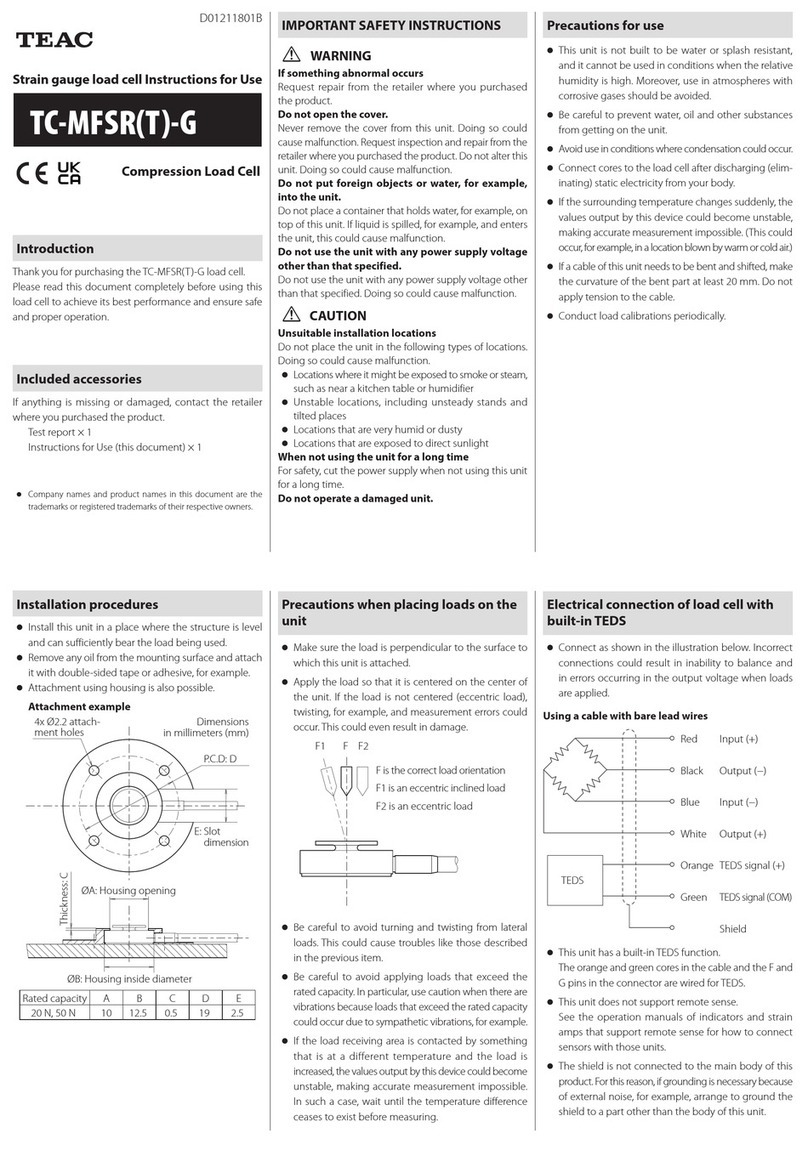
Teac
Teac TC-MFSR-G Instructions for use
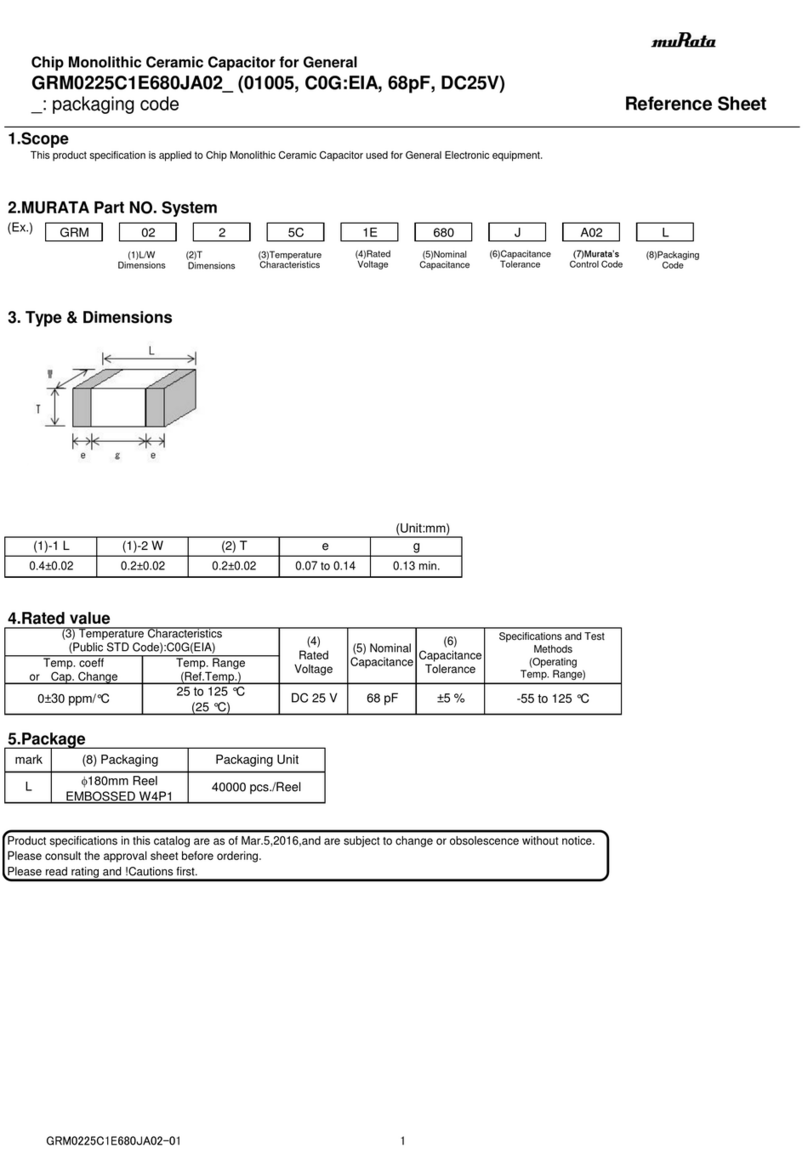
Murata
Murata GRM0225C1E680JA02 Series Reference sheet
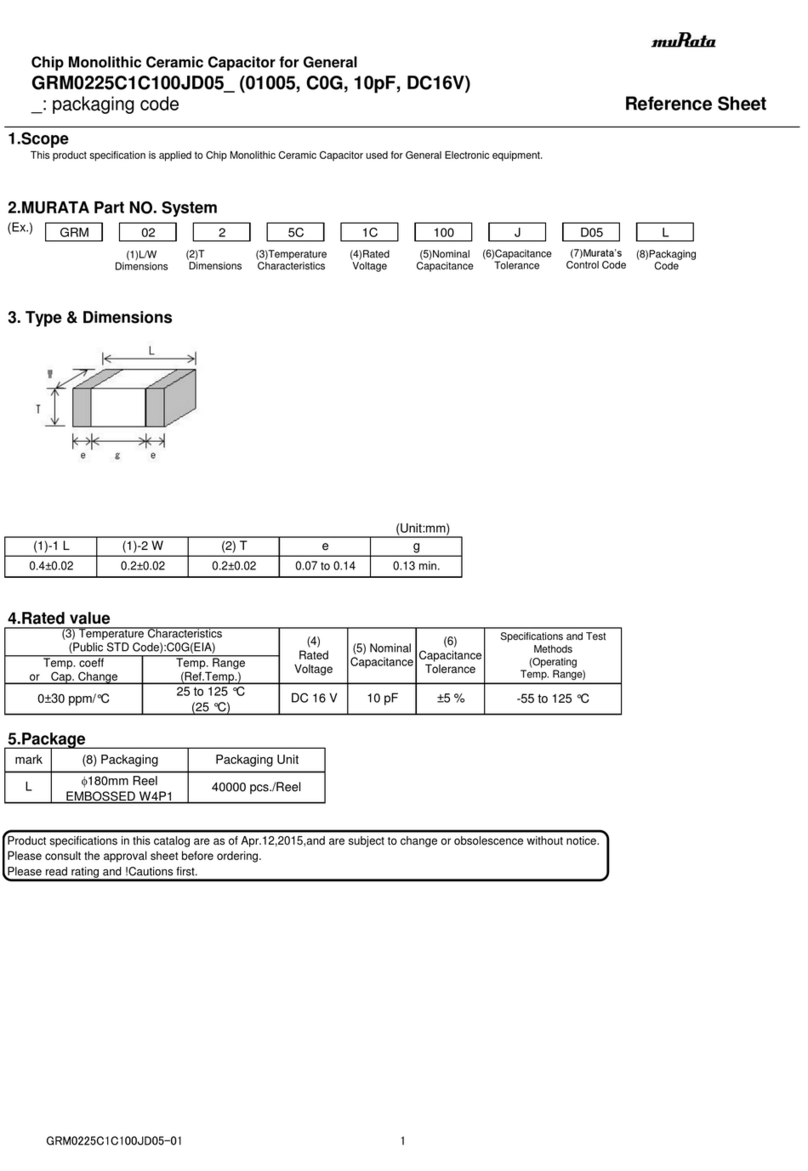
Murata
Murata GRM0225C1C100JD05 Series Reference sheet
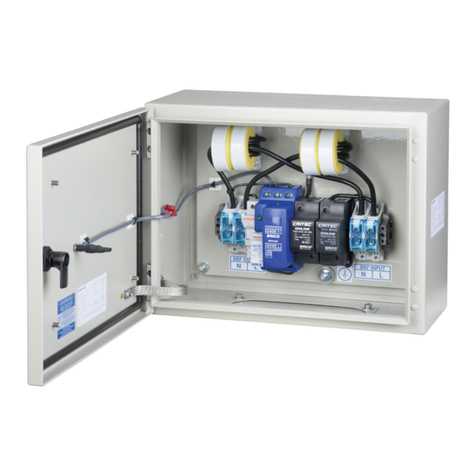
nvent
nvent ERICO SRF N Series Installation and operating instructions
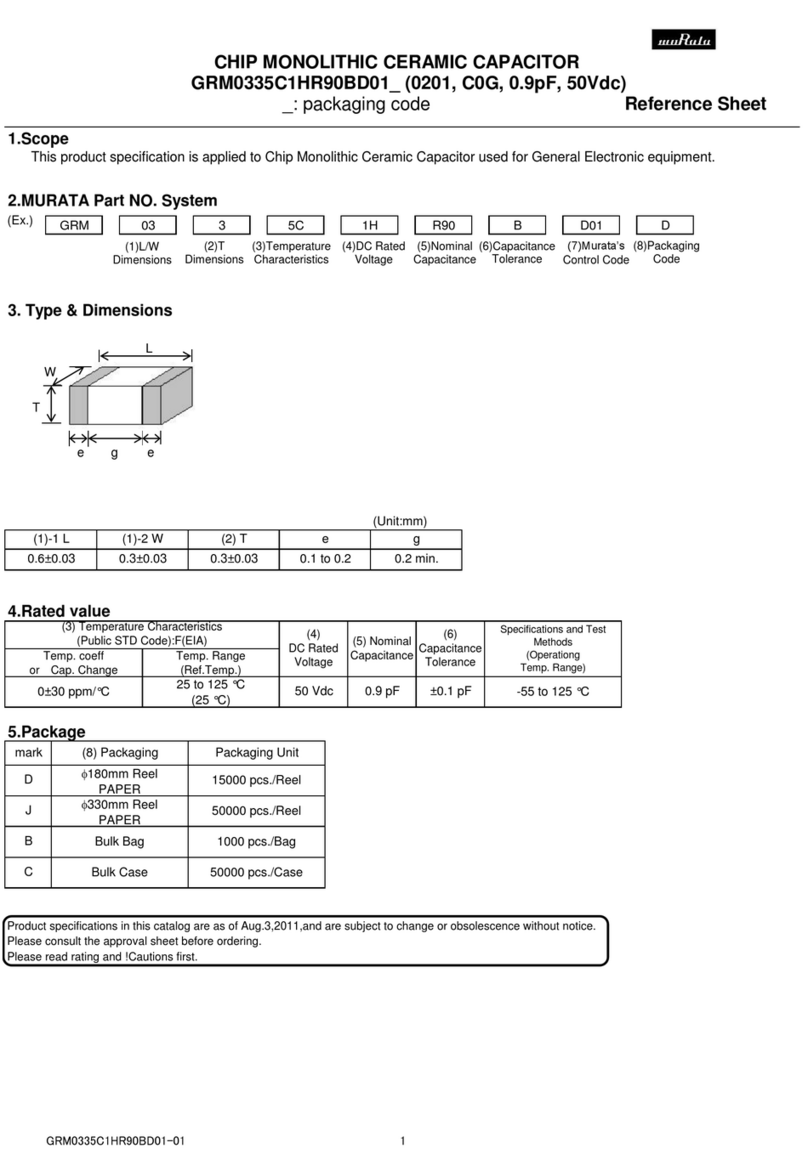
Murata
Murata GRM0335C1HR90BD01 Series Reference sheet

Siemens
Siemens Gigaset S2 Professional operating instructions

